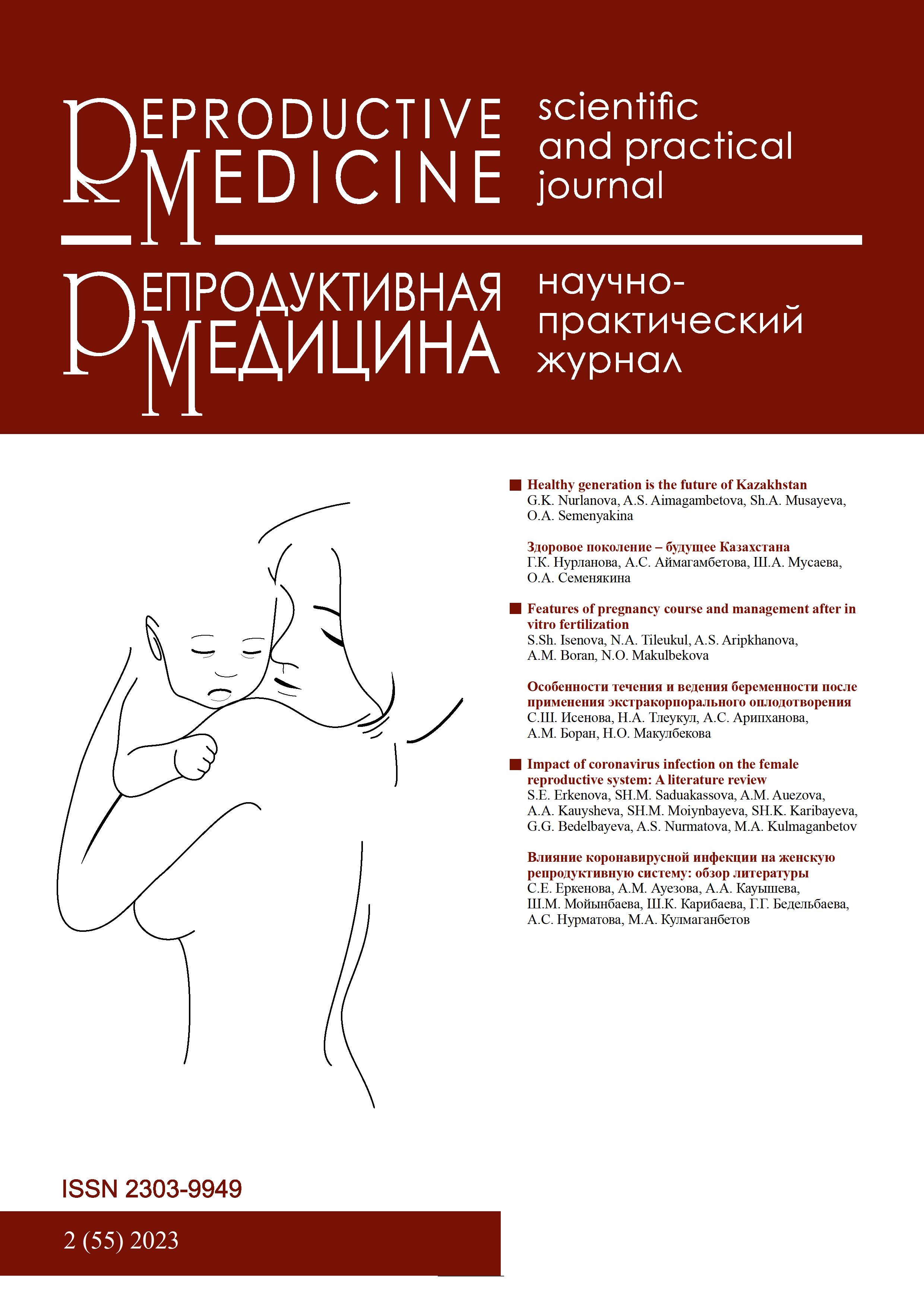Impact of air pollution on neonatal coronavirus infections in the territory of Kazakhstan
DOI:
https://doi.org/10.37800/RM.2.2023.99-108Keywords:
newborn, coronavirus infection (CVI), SARS-CoV-2 RNA virus, neonatal period, air pollutionAbstract
Relevance: Since the beginning of the pandemic, newborns with coronavirus infection (CVI) have been monitored in all significant regions of the Republic of Kazakhstan (RK). The Kazhydromet station monitoring air quality reported air pollution in the country’s megacities. Thus, statistical analysis of air quality indicators, especially pm 2.5, over the past three years showed that only in 25.6±6% of days the concentration of dust particles <2.5 microns was below the thresholds established by WHO.
The study aimed to examine the prevalence of CVI in newborns in the Republic of Kazakhstan and compare it with air pollution indicators by region.
Material and methods: We conducted a retrospective study of medical records of 619 newborn children in isolation wards of maternity hospitals and infectious diseases hospitals in 17 regions of Kazakhstan with positive results of a PCR study on SARS-CoV-2 from March 2020 to December 2022. We carried out a statistical analysis of air quality indicators.
Results: 619 newborns with confirmed CVI were included in the study in the Republic of Kazakhstan. Interestingly, in regions with a high incidence of CVI in pregnant women and newborn children, especially in large megacities such as Almaty and Astana, high levels of air pollution are noted, leading to deterioration in the health of women of reproductive age. Our data show that the high incidence of CVI among newborns is associated with high air pollution.
Conclusion: The high level of air pollution reflects the unfavorable epidemiological and environmental situation of the increase in the incidence of pregnant women and newborns in megacities. Cases of COVID-19 infection are fewer in regions with low levels of air pollution.
References
Semczuk-Kaczmarek K., Rys-Czaporowska A., Sierdzinski J., Kaczmarek L.D., Szymanski F.M., Platek A.E. Association between air pollution and COVID-19 mortality and morbidity // Intern. Emerg. Med. – 2022. – Vol. 17(2). – P. 467-473. https://doi:10.1007/s11739-021-02834-5
Casey J.A., Kioumourtzoglou M.-A., Ogburn E.L., Melamed A., Shaman J., Kandula S., Neophytou A., Darwin K.C., Sheffield J.S., Gyamfi-Bannerman C. Long-Term Fine Particulate Matter Concentrations and Prevalence of Severe Acute Respiratory Syndrome Coronavirus 2: Differential Relationships by Socioeconomic Status Among Pregnant Individuals in New York City // Am. J. Epidemiol. – 2022. – Vol. 191(11). – P. 1897-1905. https://doi.org/10.1093/aje/kwac139
Rzymski P., Poniedziałek B., Rosińska J., Ciechanowski P., Peregrym M., Pokorska-Śpiewak M., Talarek E., Zaleska I., Frańczak-Chmura P., Pilarczyk M., Figlerowicz M., Kucharek I., Flisiak R. Air pollution might affect the clinical course of COVID-19 in pediatric patients // Ecotoxicol. Environ. Saf. – 2022. – Vol. 239. – Art. no. 113651. https://doi.org/10.1016/j.ecoenv.2022.113651
MacIntyre E.A., Gehring U., Mölter A., Fuertes E., Klümper C., Krämer U., Quass U., Hoffmann B., Gascon M., Brunekreef B., Koppelman G.H., Beelen R., Hoek G., Birk M., de Jongste J.C., Smit H.A., Cyrys J., Gruzieva O., Korek M., Bergström A., Agius R.M., de Vocht F., Simpson A., Porta D., Forastiere F., Badaloni C., Cesaroni G., Esplugues A., Fernández-Somoano A., Lerxundi A., Sunyer J., Cirach M., Nieuwenhuijsen M.J., Pershagen G., Heinrich J. Air pollution and respiratory infections during early childhood: an analysis of 10 European birth cohorts within the ESCAPE project // Environ. Health Perspect. – 2014. – Vol. 122. – P. 107-113. https://doi.org/10.1289/ehp.1306755
Smith V., Seo D., Warty R., Payne O., Salih M., Chin K.L., Ofori-Asenso R., Krishnan S., da Silva Costa F., Vollenhoven B., Wallace E. Maternal and neonatal outcomes associated with COVID-19 infection: a systematic review // PLoS One. – 2020. – Vol. 15. – Art. no. e0234187. https://doi.org/10.1371/journal.pone.0234187
Chamseddine R.S., Wahbeh F., Chervenak F., Salomon L.J., Ahmed B., Rafii A. Pregnancy and neonatal outcomes in SARS-CoV-2 infection: a systematic review // J. Pregnancy. – 2020. – Vol. 2020. – Art. no. 4592450. https://doi.org/10.1155/2020/4592450
Panda S.K., Mishra A., Pathak M. Clinical Outcome of Neonates Born to SARS-CoV-2 Positive Mothers in India: A Systematic Review and Meta-Analysis // Cureus. – 2022. – Vol. 14(3). – Art. no. e22958. https://doi.org/10.7759/cureus.22958
Kerimray A., Baimatova N., Ibragimova O.P., Bukenov B., Kenessov B., Plotitsyn P., Karaca F. Assessing air quality changes in large cities during COVID-19 lockdowns: The impacts of traffic-free urban conditions in Almaty, Kazakhstan // Sci. Total Environ. – 2020. – Vol. 730. – Art. no. 139179. https://doi.org/10.1016/j.scitotenv.2020.139179
Downloads
Published
How to Cite
Issue
Section
License
The articles published in this Journal are licensed under the CC BY-NC-ND 4.0 (Creative Commons Attribution – Non-Commercial – No Derivatives 4.0 International) license, which provides for their non-commercial use only. Under this license, users have the right to copy and distribute the material in copyright but are not permitted to modify or use it for commercial purposes. Full details on the licensing are available at https://creativecommons.org/licenses/by-nc-nd/4.0/.





